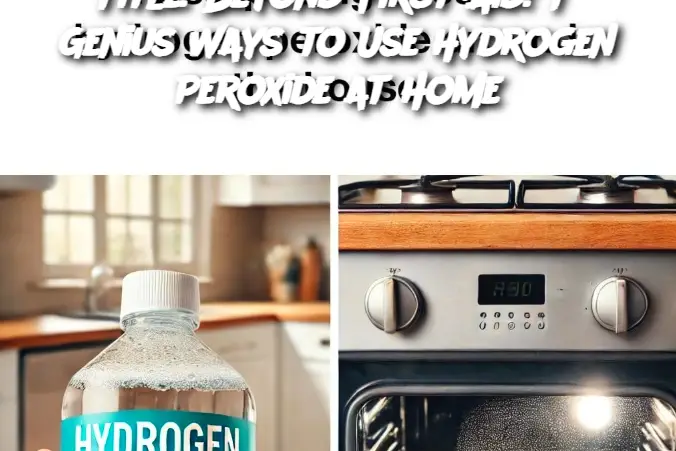-
Whiten Grout:
-
Mix hydrogen peroxide with baking soda into a paste. Apply to grout, scrub, and rinse for brighter tile lines.
-
-
Sanitize Cutting Boards:
-
Spray directly on wooden or plastic cutting boards. Let sit for 5 minutes, then rinse. It kills germs without harsh chemicals.
-
-
Disinfect Sponges:
-
Soak sponges in a 1:1 solution of hydrogen peroxide and water for 10 minutes to eliminate bacteria and odors.
-
-
Brighten White Laundry:
-
Add 1 cup of hydrogen peroxide to a load of whites to boost brightness and remove stains.
-
-
Clean the Toilet Bowl:
-
Pour 1/2 cup into the toilet. Let sit for 30 minutes, scrub, then flush for a sparkling bowl.
-
-
Freshen Shower Curtains:
-
Spray mildew-prone areas with hydrogen peroxide to stop mold in its tracks. Rinse after 10 minutes.
-
-
Clean Your Toothbrush:
-
Soak toothbrushes in hydrogen peroxide for a few minutes to kill bacteria. Rinse thoroughly before use.
-
-
Sanitize Fridge Shelves:
-
Spray on shelves and bins, wipe with a clean cloth. It kills germs without strong chemical smells.
-
-
Remove Blood Stains from Fabric:
-
Dab hydrogen peroxide directly onto fresh blood stains. Blot gently, then launder as usual.
-
-
Deodorize Sneakers:
-
Spray the inside of shoes to kill odor-causing bacteria. Let air dry completely before wearing.
-
Clean Makeup Brushes:
-
Soak in a mix of warm water, hydrogen peroxide, and a drop of dish soap. Rinse well and air dry.
-
Shine Mirrors and Glass:
-
Spray and wipe with a microfiber cloth for a streak-free finish.
-
Disinfect Doorknobs and Light Switches:
-
A simple spray-and-wipe routine keeps high-touch surfaces germ-free.
-
Revive Moldy Walls:
-
Spray onto spots of mildew or mold, let sit, and scrub. Be sure to ventilate the room.
-
Clean Pet Toys and Bowls:
-
Soak toys or dishes in hydrogen peroxide and water for 10 minutes. Rinse thoroughly before giving them back to your pet.
Serving and Storage Tips (Making the Most of Hydrogen Peroxide):
-
Use in an Opaque Bottle: Hydrogen peroxide breaks down in light—store it in a dark or original container.
-
Label Clearly: If transferring to a spray bottle, label it and keep it out of reach of children.
-
Test Surfaces First: Always spot-test on a small area to ensure it doesn’t bleach or damage surfaces.
-
Use Fresh Solution: Once opened, hydrogen peroxide gradually loses potency—replace your bottle every 6 months for best results.
Variants (Other Creative Uses to Try):
-
Mouth Rinse (Diluted): Mix with water (1:1) to create a gentle antibacterial mouthwash—do not swallow.
-
Plant Fungus Treatment: Spray lightly diluted peroxide on soil or leaves to combat fungal issues.
-
Veggie Wash: Use a diluted solution to clean produce and kill bacteria.
-
Dishwasher Cleaner: Pour 1/2 cup into the bottom and run an empty cycle for a deep clean.
-
Carpet Spot Treatment: Treat pet stains or spills by spraying a mix of peroxide and mild soap, then blotting clean.
FAQ:
Q: Is hydrogen peroxide safe on all surfaces?
A: It’s generally safe but can bleach or damage some materials like colored fabrics or granite. Always do a patch test first.
Q: Can I mix hydrogen peroxide with vinegar?
A: Yes—but never in the same container. Spray one after the other for a powerful disinfecting effect (e.g., on countertops), but mixing them directly creates peracetic acid, which can be harmful.
Q: What concentration should I use?
A: 3% hydrogen peroxide is safe and effective for most household tasks. Stronger concentrations are for industrial use and not recommended at home.
Q: Is it eco-friendly?
A: Yes! Hydrogen peroxide breaks down into water and oxygen, making it a safe alternative to many harsh chemical cleaners.
Q: Can I use it on wounds too?
A: Yes, but use it sparingly. While it kills bacteria, it can also damage healthy cells. For minor cuts, it’s okay occasionally, but plain soap and water are better for routine wound care.
Conclusion:
Hydrogen peroxide is a quiet powerhouse in any household—effective, affordable, and eco-friendly. With these 15 clever uses, you can transform your cleaning routine, disinfect your home, and solve everyday problems without relying on harsh chemicals. One bottle, endless possibilities
